风险管理(英文版)
- 格式:doc
- 大小:204.50 KB
- 文档页数:5
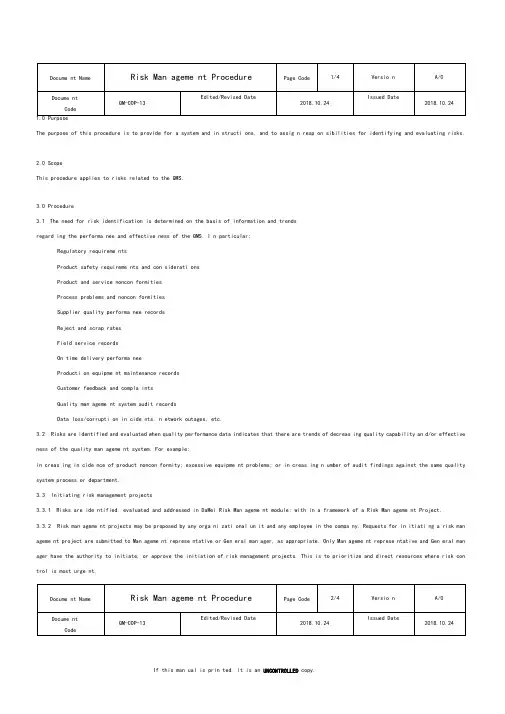
The purpose of this procedure is to provide for a system and in structi ons, and to assig n resp on sibilities for identifying and evaluating risks.2.0 ScopeThis procedure applies to risks related to the QMS.3.0 Procedure3.1The need for risk identification is determined on the basis of information and trendsregard ing the performa nee and effective ness of the QMS. I n particular:Regulatory requireme ntsProduct safety requireme nts and con siderati onsProduct and service noncon formitiesProcess problems and noncon formitiesSupplier quality performa nee recordsReject and scrap ratesField service recordsOn time delivery performa neeProducti on equipme nt maintenance recordsCustomer feedback and compla intsQuality man ageme nt system audit recordsData loss/corrupti on in cide nts, n etwork outages, etc.3.2Risks are identified and evaluated when quality performance data indicates that there are trends of decreas ing quality capability an d/or effective ness of the quality man ageme nt system. For example:in creas ing in cide nce of product noncon formity; excessive equipme nt problems; or in creas ing n umber of audit findings against the same quality system process or department.3.3Initiating risk management projects3.3.1Risks are ide ntified, evaluated and addressed in DaMei Risk Man ageme nt module; with in a framework of a Risk Man ageme nt Project.3.3.2Risk man ageme nt projects may be proposed by any orga ni zati onal un it and any employee in the compa ny. Requests for in itiati ng a risk man ageme nt project are submitted to Man ageme nt represe ntative or Gen eral man ager, as appropriate. Only Man ageme nt represe ntative and Gen eral man ager have the authority to initiate, or approve the initiation of risk management projects. This is to prioritize and direct resources where risk con trol is most urge nt.4.0 Risk man ageme nt project4.1Risk management projects are initiated in DaMei Risk Management module using electronic form EF-380-1 Risk Project.4.2When initiating a new project, select in form EF-380-1 the risk assessment method that will be used for the project:1)Hazard Evaluation: This is a method for evaluating hazards and related harms, rather than estimating the actual risks. The method is based on evaluating hazardous situations and associated harms (risk cases), and existing controls that reduce the likelihood of the hazardous situation occurring and/or reduce the severity of the harm. The evaluation results in a decision whether additional controls need to be implemented to further reduce risk. Although no a full fledged risk analysis, it is an excellent method for dem on strati ng 'risk based thinking' without going into formal and complex risk an alysis studies. This method should not be used when evaluating risks related to the safety of medical devices.2)Risk Matrix Analysis: This is a structured, formal method for assessing risks using a risk matrix. The risk matrix for the project is defined usinga template provided in formEF-380-01 (click the Risk Matrix tab in the form). This method is often referred to in technical literature as a Prelim inary Hazard An alysis (PHA). It is a top-dow n approach, using a list of known hazards as in put for the risk analysis. The risk matrix method is the most flexible and versatile, as it can be applied to any product, process or system, and does not require detailed kno wledge about the system to be an alyzed. Where appropriate, the risk matrix Analysis method should be used when evaluating risks related to the safety of medical devices.Other Method: Select this item when some other risk assessment method will be used, for example: Failure Mode Effects An alysis (FMEA), Failure Mode, Effects and Criticality An alysis (FMECA), Fault Tree Analysis (FTA), Hazard Analysis and Critical Control Points (HACCP), etc.4.3Risk man ageme nt projects are periodically reviewed to en sure that they remai n releva nt and up to date. Review dates are scheduled, and the review are docume nted in form EF-380-1 in the 'Reviews' block.5.0 Hazards5.1Hazards are con diti ons, circumsta nces, practices or other 'thi ngs' that can be a source of harm or loss. Hazards do not cause harms; they just make harms possible. Hazards are usually con sta nt, i.e., they are always there, unl ess the hazard is completely removed.5.2For each risk man ageme nt project ide ntify all releva nt hazards and en ter them into DaMei Risk Man ageme nt module (select the project and en ter hazards into the 'Hazards' grid).。
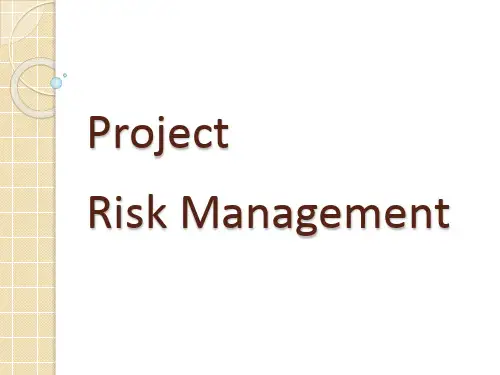
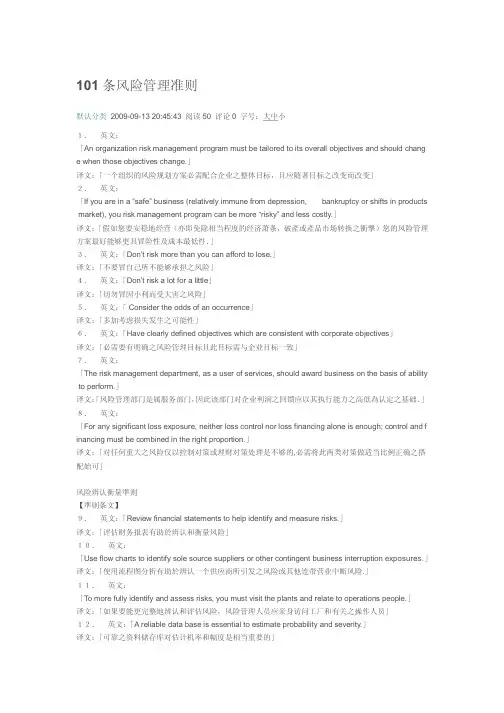
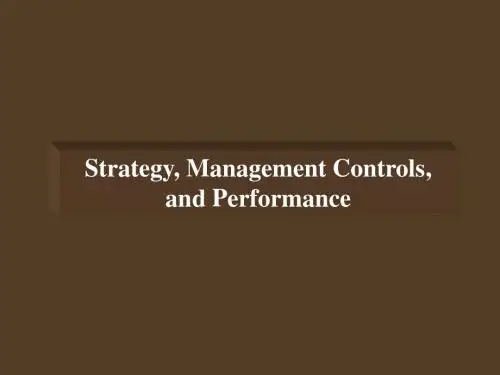
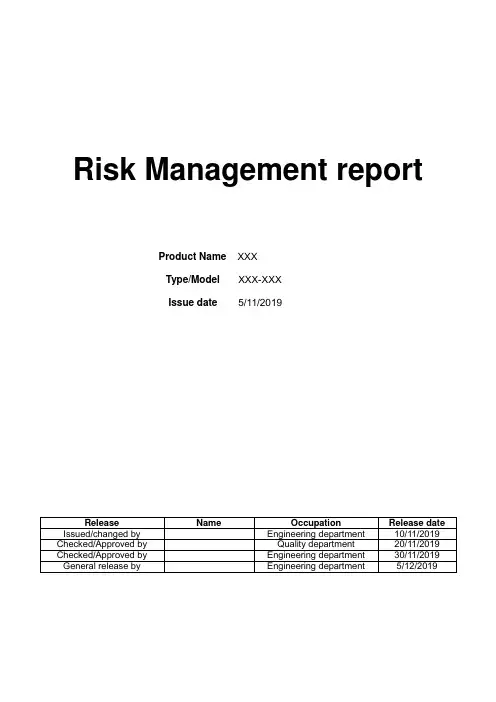


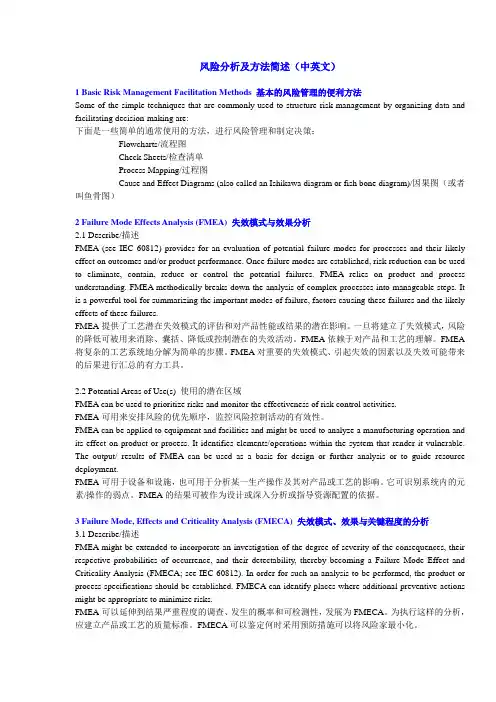
风险分析及方法简述(中英文)1 Basic Risk Management Facilitation Methods 基本的风险管理的便利方法Some of the simple techniques that are commonly used to structure risk management by organizing data and facilitating decision-making are:下面是一些简单的通常使用的方法,进行风险管理和制定决策:Flowcharts/流程图Check Sheets/检查清单Process Mapping/过程图Cause and Effect Diagrams (also called an Ishikawa diagram or fish bone diagram)/因果图(或者叫鱼骨图)2 Failure Mode Effects Analysis (FMEA) 失效模式与效果分析2.1 Describe/描述FMEA (see IEC 60812) provides for an evaluation of potential failure modes for processes and their likely effect on outcomes and/or product performance. Once failure modes are established, risk reduction can be used to eliminate, contain, reduce or control the potential failures. FMEA relies on product and process understanding. FMEA methodically breaks down the analysis of complex processes into manageable steps. It is a powerful tool for summarizing the important modes of failure, factors causing these failures and the likely effects of these failures.FMEA提供了工艺潜在失效模式的评估和对产品性能或结果的潜在影响。
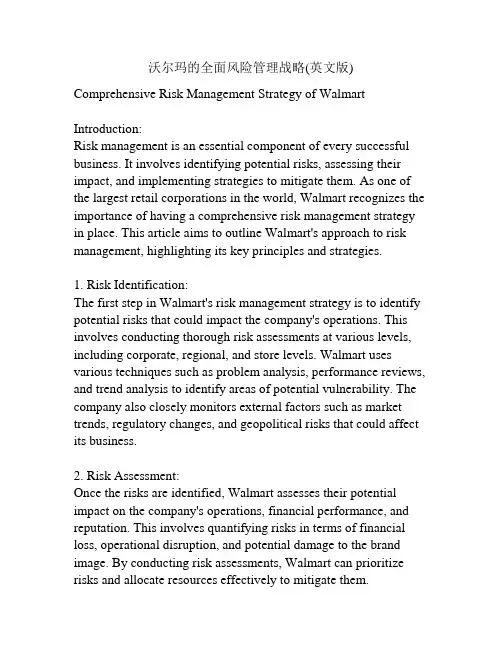
沃尔玛的全面风险管理战略(英文版) Comprehensive Risk Management Strategy of Walmart Introduction:Risk management is an essential component of every successful business. It involves identifying potential risks, assessing their impact, and implementing strategies to mitigate them. As one of the largest retail corporations in the world, Walmart recognizes the importance of having a comprehensive risk management strategy in place. This article aims to outline Walmart's approach to risk management, highlighting its key principles and strategies.1. Risk Identification:The first step in Walmart's risk management strategy is to identify potential risks that could impact the company's operations. This involves conducting thorough risk assessments at various levels, including corporate, regional, and store levels. Walmart uses various techniques such as problem analysis, performance reviews, and trend analysis to identify areas of potential vulnerability. The company also closely monitors external factors such as market trends, regulatory changes, and geopolitical risks that could affect its business.2. Risk Assessment:Once the risks are identified, Walmart assesses their potential impact on the company's operations, financial performance, and reputation. This involves quantifying risks in terms of financial loss, operational disruption, and potential damage to the brand image. By conducting risk assessments, Walmart can prioritize risks and allocate resources effectively to mitigate them.3. Risk Mitigation Strategies:After assessing the risks, Walmart implements strategies to mitigate them and minimize their impact on the company. This includes developing and implementing robust internal controls, standard operating procedures, and policies to prevent and detect risks. Walmart also invests in state-of-the-art technology and infrastructure to ensure the security and efficiency of its operations. For example, the company uses advanced surveillance systems and cybersecurity measures to protect its stores and customer data from potential threats.Walmart also believes in fostering a culture of risk management throughout the organization. It educates and trains its employees on risk awareness and encourages them to report any potential risks or violations. This helps Walmart to proactively address risks and prevent potential issues before they escalate.4. Crisis Management:Despite careful planning and risk mitigation efforts, unexpected events can still occur. Walmart understands the importance of having a robust crisis management plan in place. The company has a dedicated crisis management team that is responsible for coordinating responses to various crises, such as natural disasters, product recalls, or public relations crises. Walmart's crisis management plan outlines clear procedures for communication, decision-making, and business continuity to ensure a swift and effective response to any crisis situation.5. Business Continuity Planning:Another critical aspect of Walmart's risk management strategy is business continuity planning. This involves developing strategies and procedures to ensure the continuous operation of key business functions in the event of a disruption. Walmart has comprehensive business continuity plans at both the corporate and individual store levels. These plans outline alternative operating procedures, backup systems, and recovery strategies to minimize downtime and mitigate the impact of any disruption.6. Continuous Improvement:Walmart recognizes that risk management is an ongoing process that requires continuous improvement and adaptation. The company regularly reviews and updates its risk management strategies to address emerging risks and changing business environments. It actively seeks feedback from employees, customers, and stakeholders to identify areas for improvement and implement necessary changes.Conclusion:Walmart's comprehensive risk management strategy demonstrates its commitment to ensuring the safety, security, and continuity of its operations. By adopting a proactive and holistic approach torisk management, Walmart can identify and mitigate potential risks, minimize their impact, and maintain its position as one of the world's leading retail corporations.Certainly! Here are some additional points to expand on Walmart's risk management strategy: 1. Supply Chain Risk Management:Walmart's risk management strategy includes a strong focus on supply chain management. The company recognizes thatdisruptions in its supply chain can have a significant impact on its operations and ability to serve customers. To mitigate supply chain risks, Walmart has implemented several strategies. Firstly, the company has diversified its supplier base to reduce dependency on a single supplier or region. This helps to minimize the impact of any potential disruptions, such as natural disasters or geopolitical issues. Secondly, Walmart closely collaborates with its suppliers to ensure they meet specific quality, safety, and compliance standards. The company also conducts regular audits and inspections to mitigate the risks associated with unethical practices or non-compliance.2. International Risk Management:As a global retail corporation, Walmart operates in various countries with different regulatory, political, and cultural environments. To manage the risks associated with international operations, Walmart has established a robust governance structure. The company has a dedicated international risk management team that monitors and assesses risks specific to each country. This allows Walmart to tailor its risk mitigation strategies to address the unique challenges and requirements of individual markets. Additionally, Walmart maintains strong relationships with local stakeholders, government agencies, and industry associations to proactively address any potential risks or issues that may arise.3. Data Privacy and Cybersecurity:The increasing reliance on technology and digital systems within the retail industry brings new risks such as data breaches and cyber-attacks. Walmart recognizes the importance of protecting customer and company data from potential threats. The companyhas invested heavily in cybersecurity measures, including firewalls, encryption, and constant monitoring of its systems. Walmart also regularly conducts vulnerability assessments and penetration tests to identify and address any potential weaknesses. In addition to technical safeguards, Walmart has implemented strict data privacy policies and procedures to ensure compliance with relevant regulations and protect customer privacy.4. Regulatory Compliance:Operating in a highly regulated industry, Walmart places a strong emphasis on compliance with applicable laws and regulations. The company has a dedicated legal and compliance team that monitors and ensures adherence to local, national, and international regulations. Walmart invests in training programs for its employees to ensure they are aware of and comply with relevant laws and regulations. The company also conducts regular internal audits to assess compliance and identify areas for improvement. Walmart's commitment to regulatory compliance helps to mitigate the risks associated with legal sanctions, reputational damage, and operational disruptions.5. Environmental Sustainability:Walmart recognizes the risks associated with climate change and environmental degradation and has integrated sustainable practices into its risk management strategy. The company has set ambitious goals to reduce greenhouse gas emissions, promote renewable energy, minimize waste, and conserve natural resources. By adopting sustainable business practices, Walmart reduces its exposure to potential regulatory, reputational, and operational risks. The company also works closely with its suppliers to promotesustainable sourcing and production practices throughout its supply chain.Conclusion:Walmart's comprehensive risk management strategy encompasses a wide range of areas, including risk identification, assessment, mitigation, crisis management, business continuity planning, and continuous improvement. Through its proactive and holistic approach, Walmart can effectively manage potential risks and ensure the safety, security, and continuity of its operations. By placing a strong emphasis on supply chain integrity, international risk management, data privacy, regulatory compliance, and environmental sustainability, Walmart demonstrates its commitment to long-term success and resilience in an ever-changing business landscape.。
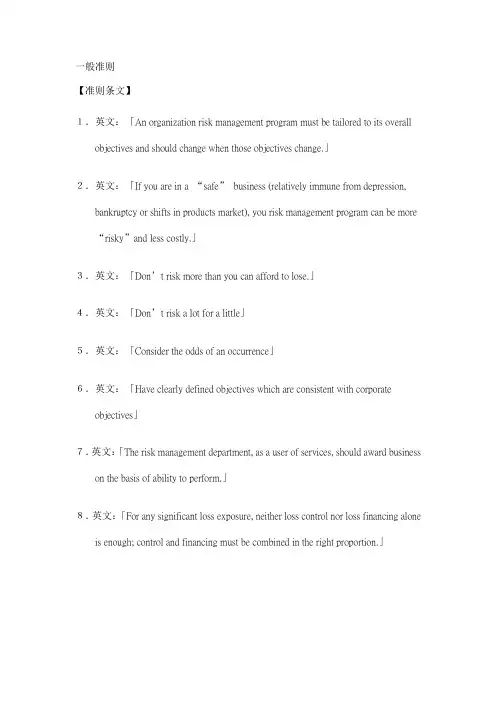
一般准则【准则条文】1.英文:「An organization risk management program must be tailored to its overall objectives and should change when those objectives change.」2.英文:「If you are in a “safe”business (relatively immune from depression, bankruptcy or shifts in products market), you risk management program can be more “risky”and less costly.」3.英文:「Don’t risk more than you can afford to lose.」4.英文:「Don’t risk a lot for a little」5.英文:「C onsider the odds of an occurrence」6.英文:「Have clearly defined objectives which are consistent with corporate objectives」7.英文:「The risk management department, as a user of services, should award business on the basis of ability to perform.」8.英文:「For any significant loss exposure, neither loss control nor loss financing alone is enough; control and financing must be combined in the right proportion.」风险辨认衡量准则【准则条文】9.英文:「Review financial statements to help identify and measure risks.」10.英文:「Use flow charts to identify sole source suppliers or other contingent business11.英文:「To more fully identify and assess risks, you must visit the plants and relate to operations people.」12.英文:「A reliable data base is essential to estimate probability and severity.」13.英文:「Accurate and timely risk information reduces risk, in any of itself.」14.英文:「The risk manager should be involved in the purchase or design of any new operation to assure that there are no built-in risk management problems.」15.英文:「Be certain environmental risks are evaluated in mergers, acquisitions and joint ventures.」16.英文:「Select hazardous waste contractors on their risk control measures and their financial stability or insurance protection. 」17.英文:「Look for incidental involvement in critical risk areas, (ie. aircraft and nuclear products, medical malpractice, engineering design, ect.)」风险控制准则【准则条文】18.英文:「Risk control works, it is cost effective and helps control local operating costs.」19.英文:「The first ( and incontrovertible ) reason for risk control is the preservation of life.」20.英文:「A property conservation program should be designed to protect corporate assets-not the underwriter.」21.英文:「Be mindful that key plants and sole source suppliers may need protection above and beyond normal HPR (highly protected risks)requirements.」22.英文:「Use the risk control services of your broker and insurer as an extension of your corporate program. Don’t let them go off on a tangent.」23.英文:「Quality control should not be substitute for a full product liability program.Quality control only assures the product is made according to specifications, whether good or bad.」24.英文:「Most of the safety-related “standards”of governmental agencies should be considered as minimum requirements.」25.英文:「Duplicate and separately store valuable papers and back-up data processing media.」26.英文:「Avoid travel by multiple executives in a single aircraft.」。
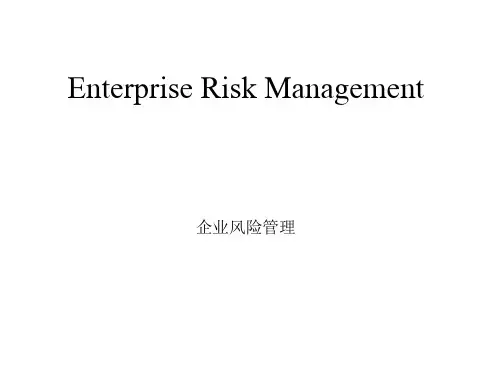
企业风险管理——整合框架2004年9月目录内容摘要企业风险管理的基础性前提是每一个主体的存在都是为它的利益相关者提供价值。
所有的主体都面临不确定性,管理当局所面临的挑战就是在为增加利益相关者价值而奋斗的同时,要确定承受多大的不确定性。
不确定性可能会破坏或增加价值,因而它既代表风险,也代表机会。
企业风险管理使管理当局能够有效地应对不确定性以及由此带来的风险和机会,增进创造价值的能力。
当管理当局通过制订战略和目标,力求实现增长和报酬目标以及相关的风险之间的最优平衡,并且在追求所在主体的目标的过程中高效率和有效地调配资源时,价值得以最大化。
企业风险管理包括:协调风险容量(risk appetite)与战略——管理当局在评价备选的战略、设定相关目标和建立相关风险的管理机制的过程中,需要考虑所在主体的风险容量。
增进风险应对决策——企业风险管理为识别和在备选的风险应对——风险回避、降低、分担和承受——之间进行选择提供了严密性。
抑减经营意外和损失——主体识别潜在事项和实施应对的能力得以增强,抑减了意外情况以及由此带来的成本或损失。
识别和管理多重的和贯穿于企业的风险——每一家企业都面临影响组织的不同部分的一系列风险,企业风险管理有助于有效地应对交互影响,以及整合式地应对多重风险。
抓住机会——通过考虑全面范围内的潜在事项,促使管理当局识别并积极地实现机会。
改善资本调配——获取强有力的风险信息,使得管理当局能够有效地评估总体资本需求,并改进资本配置。
企业风险管理所固有的这些能力帮助管理当局实现所在主体的业绩和赢利目标,防止资源损失。
企业风险管理有助于确保有效的报告以及符合法律和法规,还有助于避免对主体声誉的损害以及由此带来的后果。
总之,企业风险管理不仅帮助一个主体到达期望的目的地,还有助于避开前进途中的隐患和意外。
事项——风险与机会事项可能会带来负面的影响,也可能会带来正面的影响,抑或二者兼而有之。
带来负面影响的事项代表风险,它会妨碍价值创造或者破坏现有价值。
金融市场的风险管理(英文版)Risk Management in Financial MarketsIntroductionRisk management is a crucial aspect of the financial markets. It involves the identification, assessment, and mitigation of potential risks that may impact an organization's financial well-being. The dynamic nature of financial markets makes effective risk management imperative to ensure stability and sustainability. This article aims to explore the various aspects of risk management in financial markets.Types of RisksFinancial markets face various types of risks, each with its unique characteristics. The most common types of risks in financial markets include credit risk, market risk, liquidity risk, operational risk, and systemic risk.Credit risk refers to the potential loss arising from a borrower's inability to repay a loan or meet its contractual obligations. Financial institutions employ credit risk management techniques, such as credit scoring models and credit derivatives, to assess and mitigate this risk.Market risk encompasses the potential loss due to fluctuating market prices of financial instruments. It includes risks associated with interest rates, currencies, equities, commodities, and derivatives. Market risk management involves using techniques like portfolio diversification, hedging, and stress testing to mitigate potential losses.Liquidity risk arises when an institution is unable to fulfill its financial obligations due to an insufficient availability of liquid assets. Effective liquidity risk management involves maintaining adequate liquidity buffers, developing contingency funding plans, and regularly monitoring and stress testing liquidity positions.Operational risk involves the risk of financial loss due to inadequate or failed internal processes, systems, or human error. It includes risks associated with technology failures, fraud, legal and regulatory compliance, and vendor management. Operational risk management involves implementing robust internal controls, conducting regular audits, and training staff on risk awareness.Systemic risk refers to the risk of widespread disruptions or failures in the financial system that could have a significant impact on the overall economy. It can arise from interconnectedness and interdependencies among financial institutions, such as in the case of a financial crisis. Systemic risk management involves regulatory oversight, stress testing, and contingency planning at both the institutional and systemic levels.Risk Assessment and MitigationEffective risk management starts with a thorough and comprehensive risk assessment. This involves identifying and analyzing risks, including their potential impacts and likelihoods of occurrence. Risk assessment enables organizations to prioritize risks and allocate resources accordingly.Once risks are identified, appropriate risk mitigation strategies canbe implemented. These strategies may include risk avoidance, risk reduction, risk transfer, or risk acceptance. Risk avoidance involves refraining from activities that pose significant risks. Risk reduction involves implementing measures to minimize the likelihood or impact of risks. Risk transfer involves transferring risks to another party, such as through insurance or hedging. Risk acceptance involves acknowledging and accepting certain risks if their potential impact is deemed acceptable.Risk management frameworks and tools can also assist in the overall risk management process. These frameworks provide a structured approach to managing risks and can help organizations establish appropriate risk management policies, procedures, and controls. Examples of risk management tools include risk registers, risk appetite statements, risk and control self-assessment, and key risk indicators.Continual Monitoring and ReviewRisk management is an ongoing process that requires continuous monitoring and review. Financial institutions need to establish effective risk monitoring systems to detect and assess emerging risks promptly. Regular risk reporting and analysis help organizations stay informed about their risk profiles and take necessary actions.Risk management frameworks should also be periodically reviewed and updated to ensure their effectiveness in addressing evolving risks. As technology advances and market conditions change, risk management practices need to keep pace to effectively manage emerging risks.ConclusionRisk management is a critical component of the financial markets. The proper identification, assessment, and mitigation of risks are essential for maintaining stability and sustainability. By implementing robust risk management practices, financial institutions can navigate the challenges and uncertainties of financial markets effectively. Continued commitment to risk management ensures the soundness and integrity of the overall financial system.Sure, here's some additional content on the topic:Risk measurement and monitoring are key aspects of risk management in financial markets. Organizations use various metrics and tools to quantify and monitor risks. These include value-at-risk (VaR), stress testing, scenario analysis, and sensitivity analysis. VaR measures the potential loss in a portfolio or position under normal market conditions, with a specified confidence level. Stress testing, on the other hand, involves assessing the impact of extreme and hypothetical market scenarios on a portfolio's value. Scenario analysis involves analyzing the potential outcomes of specific events or market conditions. Sensitivity analysis assesses how changes in underlying factors, such as interest rates or exchange rates, affect the value of a portfolio.Risk management practices also extend to regulatory compliance. Financial institutions need to comply with various regulations and guidelines set by regulatory authorities. These regulations aim to safeguard the stability and integrity of the financial system and protect consumers. Risk management frameworks helporganizations ensure compliance by providing guidelines on risk assessment, reporting, and governance. Regulatory frameworks, such as Basel III, require banks to maintain adequate capital buffers to absorb potential losses and to have robust risk management systems in place.Technology plays a significant role in modern risk management. Advanced analytics tools and algorithms enable organizations to better analyze and understand risks. Artificial intelligence and machine learning can identify patterns and detect anomalies that may indicate potential risks. Risk management systems can also be automated to facilitate real-time monitoring and reporting. Technology-driven risk management helps organizations to improve risk assessment accuracy, increase efficiency, and enable faster decision-making.In addition to external risks, organizations also need to consider internal risks. Internal risks can arise from poor governance, inadequate internal controls, or unethical behaviors. Risk management frameworks often include internal control systems to ensure the effective mitigation of internal risks. These systems involve procedures and policies that promote transparency, accountability, and ethical behavior within the organization. Regular internal audits help assess the effectiveness of internal controls and identify areas for improvement.Risk management is a collective effort that involves all stakeholders in the financial markets. Regulators, financial institutions, investors, and market participants all play a role in identifying, assessing, and mitigating risks. Effective riskmanagement requires collaboration and information sharing among these stakeholders. Regulatory authorities set standards and guidelines, financial institutions implement risk management practices, investors conduct due diligence, and market participants adhere to market rules and regulations.In conclusion, risk management in financial markets is vital to ensure stability, sustainability, and trust in the financial system. It involves identifying, assessing, and mitigating various types of risks, including credit risk, market risk, liquidity risk, operational risk, and systemic risk. Risk assessment and mitigation strategies are informed by robust risk management frameworks and tools. Continual monitoring and review of risks help organizations stay informed and responsive to emerging risks. Technology and regulatory compliance also play significant roles in effective risk management. By prioritizing risk management, financial institutions can safeguard their financial well-being and contribute to the overall stability of the financial system.。
企业风险管理中英文对照外文翻译文献(文档含英文原文和中文翻译)原文:Risk ManagementThis chapter reviews and discusses the basic issues and principles of risk management, including: risk acceptability (tolerability); risk reduction and the ALARP principle; cautionary and precautionary principles. And presents a case study showing the importance of these issues and principles in a practical management context. Before we take a closer look, let us briefly address some basic features of risk management.The purpose of risk management is to ensure that adequate measures are taken to protect people, the environment, and assets from possible harmful consequences of the activities being undertaken, as well as to balance different concerns, in particular risks and costs. Risk management includes measures both to avoid the hazards and toreduce their potential harm. Traditionally, in industries such as nuclear, oil, and gas, risk management was based on a prescriptive regulating regime, in which detailed requirements were set with regard to the design and operation of the arrangements. This regime has gradually been replaced by a more goal-oriented regime, putting emphasis on what to achieve rather than on the means of achieving it.Risk management is an integral aspect of a goal-oriented regime. It is acknowledged that risk cannot be eliminated but must be managed. There is nowadays an enormous drive and enthusiasm in various industries and in society as a whole to implement risk management in organizations. There are high expectations that risk management is the proper framework through which to achieve high levels of performance.Risk management involves achieving an appropriate balance between realizing opportunities for gain and minimizing losses. It is an integral part of good management practice and an essential element of good corporate governance. It is an iterative process consisting of steps that, when undertaken in sequence, can lead to a continuous improvement in decision-making and facilitate a continuous improvement in performance.To support decision-making regarding design and operation, risk analyses are carried out. They include the identification of hazards and threats, cause analyses, consequence analyses, and risk descriptions. The results are then evaluated. The totality of the analyses and the evaluations are referred to as risk assessments. Risk assessment is followed by risk treatment, which is a process involving the development and implementation of measures to modify the risk, including measures designed to avoid, reduce (“optimize”), transfer, or retain the risk. Risk transfer means sharing with another party the benefit or loss associated with a risk. It is typically affected through insurance. Risk management covers all coordinated activities in the direction and control of an organization with regard to risk.In many enterprises, the risk management tasks are divided into three main categories: strategic risk, financial risk, and operational risk. Strategic risk includes aspects and factors that are important for the e nterprise’s long-term strategy and plans,for example mergers and acquisitions, technology, competition, political conditions, legislation and regulations, and labor market. Financial risk includes the enterprise’s financial situation, and includes: Market risk, associated with the costs of goods and services, foreign exchange rates and securities (shares, bonds, etc.). Credit risk, associated with a debtor’s failure to meet its obligations in accordance with agreed terms. Liquidity risk, reflecting lack of access to cash; the difficulty of selling an asset in a timely manner. Operational risk is related to conditions affecting the normal operating situation: Accidental events, including failures and defects, quality deviations, natural disasters. Intended acts; sabotage, disgruntled employees, etc. Loss of competence, key personnel. Legal circumstances, associated for instance, with defective contracts and liability insurance.For an enterprise to become successful in its implementation of risk management, top management needs to be involved, and activities must be put into effect on many levels. Some important points to ensure success are: the establishment of a strategy for risk management, i.e., the principles of how the enterprise defines and implements risk management. Should one simply follow the regulatory requirements (minimal requirements), or should one be the “best in the class”? The establishment of a risk management process for the enterprise, i.e. formal processes and routines that the enterprise is to follow. The establishment of management structures, with roles and responsibilities, such that the risk analysis process becomes integrated into the organization. The implementation of analyses and support systems, such as risk analysis tools, recording systems for occurrences of various types of events, etc. The communication, training, and development of a risk management culture, so that the competence, understanding, and motivation level within the organization is enhanced. Given the above fundamentals of risk management, the next step is to develop principles and a methodology that can be used in practical decision-making. This is not, however, straightforward. There are a number of challenges and here we address some of these: establishing an informative risk picture for the various decision alternatives, using this risk picture in a decision-making context. Establishing an informative risk picture means identifying appropriate risk indices and assessments ofuncertainties. Using the risk picture in a decision making context means the definition and application of risk acceptance criteria, cost benefit analyses and the ALARP principle, which states that risk should be reduced to a level which is as low as is reasonably practicable.It is common to define and describe risks in terms of probabilities and expected values. This has, however, been challenged, since the probabilities and expected values can camouflage uncertainties; the assigned probabilities are conditional on a number of assumptions and suppositions, and they depend on the background knowledge. Uncertainties are often hidden in this background knowledge, and restricting attention to the assigned probabilities can camouflage factors that could produce surprising outcomes. By jumping directly into probabilities, important uncertainty aspects are easily truncated, and potential surprises may be left unconsidered.Let us, as an example, consider the risks, seen through the eyes of a risk analyst in the 1970s, associated with future health problems for divers working on offshore petroleum projects. The analyst assigns a value to the probability that a diver would experience health problems (properly defined) during the coming 30 years due to the diving activities. Let us assume that a value of 1 % was assigned, a number based on the knowledge available at that time. There are no strong indications that the divers will experience health problems, but we know today that these probabilities led to poor predictions. Many divers have experienced severe health problems (Avon and Vine, 2007). By restricting risk to the probability assignments alone, important aspects of uncertainty and risk are hidden. There is a lack of understanding about the underlying phenomena, but the probability assignments alone are not able to fully describe this status.Several risk perspectives and definitions have been proposed in line with this realization. For example, Avon (2007a, 2008a) defines risk as the two-dimensional combination of events/consequences and associated uncertainties (will the events occur, what the consequences will be). A closely related perspective is suggested by Avon and Renan (2008a), who define risk associated with an activity as uncertaintyabout and severity of the consequences of the activity, where severity refers to intensity, size, extension, scope and other potential measures of magnitude with respect to something that humans value (lives, the environment, money, etc.). Losses and gains, expressed for example in monetary terms or as the number of fatalities, are ways of defining the severity of the consequences. See also Avon and Christensen (2005).In the case of large uncertainties, risk assessments can support decision-making, but other principles, measures, and instruments are also required, such as the cautionary/precautionary principles as well as robustness and resilience strategies. An informative decision basis is needed, but it should be far more nuanced than can be obtained by a probabilistic analysis alone. This has been stressed by many researchers, e.g. Apostolicism (1990) and Apostolicism and Lemon (2005): qualitative risk analysis (QRA) results are never the sole basis for decision-making. Safety- and security-related decision-making is risk-informed, not risk-based. This conclusion is not, however, justified merely by referring to the need for addressing uncertainties beyond probabilities and expected values. The main issue here is the fact that risks need to be balanced with other concerns.When various solutions and measures are to be compared and a decision is to be made, the analysis and assessments that have been conducted provide a basis for such a decision. In many cases, established design principles and standards provide clear guidance. Compliance with such principles and standards must be among the first reference points when assessing risks. It is common thinking that risk management processes, and especially ALARP processes, require formal guidelines or criteria (e.g., risk acceptance criteria and cost-effectiveness indices) to simplify the decision-making. Care must; however, be shown when using this type of formal decision-making criteria, as they easily result in a mechanization of the decision-making process. Such mechanization is unfortunate because: Decision-making criteria based on risk-related numbers alone (probabilities and expected values) do not capture all the aspects of risk, costs, and benefits, no method has a precision that justifies a mechanical decision based on whether the result is overor below a numerical criterion. It is a managerial responsibility to make decisions under uncertainty, and management should be aware of the relevant risks and uncertainties.Apostolicism and Lemon (2005) adopt a pragmatic approach to risk analysis and risk management, acknowledging the difficulties of determining the probabilities of an attack. Ideally, they would like to implement a risk-informed procedure, based on expected values. However, since such an approach would require the use of probabilities that have not b een “rigorously derived”, they see themselves forced to resort to a more pragmatic approach.This is one possible approach when facing problems of large uncertainties. The risk analyses simply do not provide a sufficiently solid basis for the decision-making process. We argue along the same lines. There is a need for a management review and judgment process. It is necessary to see beyond the computed risk picture in the form of the probabilities and expected values. Traditional quantitative risk analyses fail in this respect. We acknowledge the need for analyzing risk, but question the value added by performing traditional quantitative risk analyses in the case of large uncertainties. The arbitrariness in the numbers produced can be significant, due to the uncertainties in the estimates or as a result of the uncertainty assessments being strongly dependent on the analysts.It should be acknowledged that risk cannot be accurately expressed using probabilities and expected values. A quantitative risk analysis is in many cases better replaced by a more qualitative approach, as shown in the examples above; an approach which may be referred to as a semi-quantitative approach. Quantifying risk using risk indices such as the expected number of fatalities gives an impression that risk can be expressed in a very precise way. However, in most cases, the arbitrariness is large. In a semi-quantitative approach this is acknowledged by providing a more nuanced risk picture, which includes factors that can cause “surprises” r elative to the probabilities and the expected values. Quantification often requires strong simplifications and assumptions and, as a result, important factors could be ignored or given too little (or too much) weight. In a qualitative or semi-quantitative analysis, amore comprehensive risk picture can be established, taking into account underlying factors influencing risk. In contrast to the prevailing use of quantitative risk analyses, the precision level of the risk description is in line with the accuracy of the risk analysis tools. In addition, risk quantification is very resource demanding. One needs to ask whether the resources are used in the best way. We conclude that in many cases more is gained by opening up the way to a broader, more qualitative approach, which allows for considerations beyond the probabilities and expected values.The traditional quantitative risk assessments as seen for example in the nuclear and the oil & gas industries provide a rather narrow risk picture, through calculated probabilities and expected values, and we conclude that this approach should be used with care for problems with large uncertainties. Alternative approaches highlighting the qualitative aspects are more appropriate in such cases. A broad risk description is required. This is also the case in the normative ambiguity situations, as the risk characterizations provide a basis for the risk evaluation processes. The main concern is the value judgments, but they should be supported by solid scientific assessments, showing a broad risk picture. If one tries to demonstrate that it is rational to accept risk, on a scientific basis, too narrow an approach to risk has been adopted. Recognizing uncertainty as a main component of risk is essential to successfully implement risk management, for cases of large uncertainties and normative ambiguity.A risk description should cover computed probabilities and expected values, as well as: Sensitivities showing how the risk indices depend on the background knowledge (assumptions and suppositions); Uncertainty assessments; Description of the background knowledge, including models and data used.The uncertainty assessments should not be restricted to standard probabilistic analysis, as this analysis could hide important uncertainty factors. The search for quantitative, explicit approaches for expressing the uncertainties, even beyond the subjective probabilities, may seem to be a possible way forward. However, such an approach is not recommended. Trying to be precise and to accurately express what is extremely uncertain does not make sense. Instead we recommend a more openqualitative approach to reveal such uncertainties. Some might consider this to be less attractive from a methodological and scientific point of view. Perhaps it is, but it would be more suited for solving the problem at hand, which is about the analysis and management of risk and uncertainties.Source: Terje Aven. 2010. “Risk Management”. Risk in Technological Systems, Oct, p175-198.译文:风险管理本章回顾和讨论风险管理的基本问题和原则,包括:风险可接受性(耐受性)、风险削减和安全风险管理原则、警示和预防原则,并提出了一个研究案例,说明在实际管理环境中这些问题和原则的重要性。